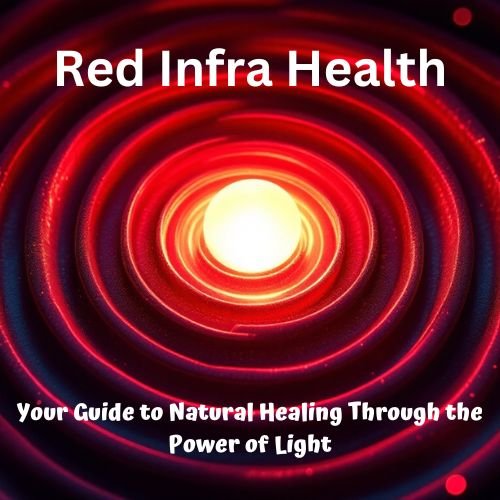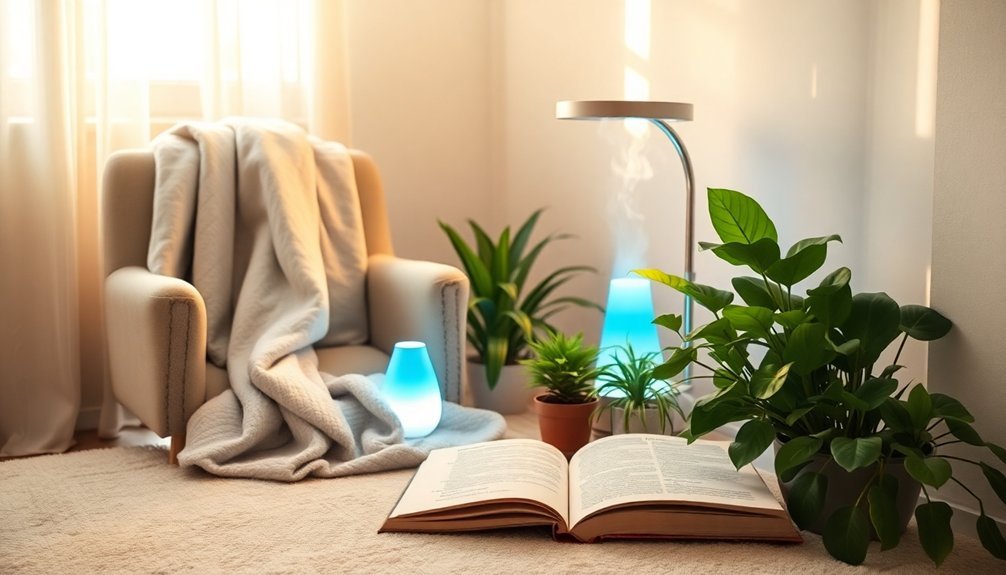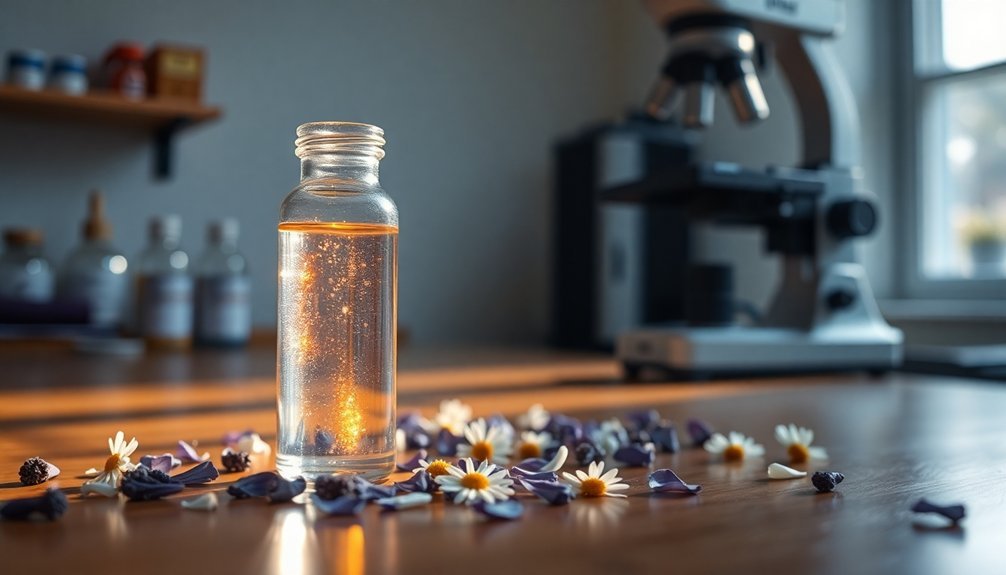Red light therapy can naturally boost your testosterone through targeted treatments that stimulate Leydig cells and improve blood flow. You'll get the best results using wavelengths between 660-850nm for 10-20 minutes, 3-4 times weekly, during morning sessions. Apply the light directly to your lower abdomen and groin area while maintaining proper distance. Combine your treatments with high-intensity workouts, compound exercises, and a ketogenic diet to maximize testosterone production. Follow safety guidelines and use quality LED devices that offer both red and near-infrared light options. The science behind these methods reveals even more powerful ways to enhance your hormonal health.
Red Light For Male Vitality

Men seeking natural testosterone support are discovering the powerful effects of red light therapy. This innovative treatment enhances blood flow by stimulating nitric oxide production, which relaxes blood vessels and improves circulation to essential areas. Just ten minutes daily is all that's needed to achieve these benefits.
You'll experience better muscle recovery and increased energy levels while reducing stress that can impact your well-being.
The therapy's impact on hormone regulation is particularly significant for male health. Clinical studies show that red light exposure can elevate testosterone levels, directly influencing your sex drive and overall satisfaction. It works by enhancing your cellular energy production through improved ATP, while simultaneously fighting inflammation that can disrupt hormone balance.
You'll benefit from red light's deep-penetrating action, which energizes cells and triggers new growth at the tissue level. The treatment's ability to boost mitochondrial function means you're supporting your body at its most fundamental level.
For the best results, you can combine red light therapy with complementary treatments like cryotherapy and targeted supplementation. Consider adding zinc and vitamin D to your regimen while maintaining regular exercise and proper sleep patterns to maximize the therapy's testosterone-supporting benefits.
Optimal Infrared Wavelengths
When you're looking to boost testosterone through light therapy, choosing the right wavelengths makes all the difference for ideal results.
You'll want to focus on the red light spectrum at 660 nanometers and near-infrared at 850 nanometers, as these specific wavelengths have proven most effective for stimulating testosterone production in the Leydig cells.
These wavelengths work by optimizing ATP production in your cells, supporting healthy testosterone synthesis.
Your exposure sessions should last 10-20 minutes and occur 3-4 times weekly to maximize the therapeutic benefits of these precise wavelengths.
Therapeutic Light Exposure Benefits
The science behind therapeutic light exposure reveals specific wavelengths that optimize testosterone production naturally. You'll find that combining short red LED waves (630-700 nm) with longer NIR waves (700-900 nm) delivers the most potent testosterone-boosting effects. These wavelengths work together to stimulate your Leydig cells, increasing testosterone from 2.3 to 3.6 nanograms per milliliter within two weeks. Studies show that seasonal daylight duration significantly impacts these results, with peak effectiveness occurring during morning treatments.
| Light Type | Wavelength Range | Benefits |
|---|---|---|
| Short Red LED | 630-700 nm | Activates cellular energy production |
| Near-Infrared | 700-900 nm | Penetrates deep tissue without heat |
| UV-Filtered | Morning exposure | Triples sexual satisfaction scores |
| Blue Light | Avoid | Causes DNA damage, reduces T levels |
When you expose yourself to the right wavelengths, you'll experience improved sexual satisfaction, with scores increasing from 2 to 6.3 on a 1-10 scale. The therapy doesn't just boost testosterone – it enhances sperm motility, athletic performance, and cognitive function. You can safely use FDA-approved red light devices at home as a natural alternative to traditional testosterone replacement therapy, avoiding the risks associated with synthetic hormone treatments.
Peak Wavelength Selection Guide
Building on what's understood about therapeutic light exposure, selecting the right wavelength combination maximizes your testosterone-boosting results. The most effective approach combines visible red light (600-650 nm) with near-infrared light (800-850 nm).
This dual-wavelength strategy penetrates both superficial and deep tissue layers, enhancing stimulation of Leydig cells and mitochondrial function. Sex drive improvements can be achieved through consistent therapy sessions, as testosterone plays a vital role in maintaining healthy libido levels.
You'll want to focus on devices that deliver wavelengths within the proven 600-1000 nm range, with particular attention to the scientifically validated peaks of 660 nm and 850 nm. These specific wavelengths have demonstrated superior results in enhancing ATP production and testosterone secretion in clinical studies.
- Choose devices offering both red (600-650 nm) and near-infrared (800-850 nm) wavelengths for thorough tissue penetration
- Target an energy density below 100 J/cm² and irradiance between 20-200 mW/cm² for ideal results
- Apply treatment directly to the lower abdomen or groin area for 10-20 minutes daily
When selecting your device, make certain it provides sufficient intensity to reach deeper tissues while maintaining the recommended exposure parameters. This combination of proper wavelength selection and application technique creates the foundation for effective testosterone enhancement through light therapy.
Morning Red Light Sessions

For ideal testosterone production, scheduling your red light therapy sessions in the morning can deliver remarkable benefits. Your testosterone levels naturally peak during morning hours, making it the perfect time to amplify this effect with targeted light exposure.
Even a brief 5-minute session can effectively boost your hormone levels while synchronizing with your body's natural circadian rhythms.
The science behind morning sessions is compelling. Red light therapy stimulates your Leydig cells' mitochondria, optimizing oxygen use and increasing ATP production. This enhanced cellular energy directly supports steroidogenesis, leading to higher testosterone levels – some studies show it can nearly double your numbers.
You'll likely notice improvements in energy, libido, and overall sexual satisfaction.
To get the best results, you'll want to use devices that combine red LED waves (630-700 nm) and NIR waves (700-900 nm). These wavelengths are completely safe, even for sensitive areas like the testicles, as they don't generate harmful heat.
You can perform these sessions at home using FDA-approved devices, making it a convenient addition to your morning routine without recurring costs or time-consuming clinic visits.
Direct Light Exposure Methods
Various direct light exposure methods can substantially boost your testosterone levels when implemented correctly.
Your most effective approach is to get 15-30 minutes of direct sunlight exposure early in the morning, ideally right after waking up. This timing can increase your luteinizing hormone levels by nearly 70%, which directly impacts testosterone production.
When natural sunlight isn't available, you can use light therapy lamps that provide 10,000 lux for 30 minutes daily.
The exposure of UV light to your skin triggers your pituitary gland to release hormones that stimulate testosterone production. Mid-day to late-day sun exposure can be particularly effective, as UVB rays help activate skin cells and boost vitamin D levels, which further supports testosterone production.
- Get morning sunlight exposure for 15-30 minutes immediately after waking up
- Use a 10,000 lux light therapy lamp for 30 minutes when sunlight isn't available
- Expose larger areas of skin (chest, stomach) to sunlight safely to maximize benefits
Remember to balance your sun exposure carefully to avoid skin damage. If you're concerned about UV radiation, you can supplement with vitamin D to support testosterone production while minimizing risk.
Red Light Exercise Integration

While direct sunlight provides natural testosterone benefits, integrating red light therapy with your exercise routine can amplify your hormonal response substantially. By combining high-intensity workouts with red light exposure, you'll optimize your body's testosterone production through multiple pathways.
Focus your workouts on compound movements like deadlifts, squats, and bench presses using heavy weights with low repetitions. These exercises naturally boost testosterone, and when paired with red light therapy, they'll enhance ATP production in your Leydig cells.
Schedule your red light sessions either before or after your training to maximize the stimulation of testicular photoreceptors.
You'll want to incorporate high-intensity interval training and sprint work into your routine, as these activities particularly benefit from red light therapy's ability to improve muscle performance and recovery. Remember to allow adequate rest periods between sets to optimize your hormone response.
If you're new to resistance training, start with basic exercises like push-ups while gradually introducing red light therapy into your routine.
Track your progress consistently and adjust your combined protocol as needed. The key is maintaining regular exposure to both exercise and red light therapy for sustained testosterone enhancement.
Combining Nutrition With Light Therapy
The synergistic effects of proper nutrition and red light therapy can dramatically amplify your testosterone production potential.
When you combine a ketogenic diet maintaining serum ketones above 0.5 mmol/L with red light therapy, you'll experience enhanced expression of primary sex hormones. This nutritional approach increases bioavailable cholesterol and DHEA, while red light therapy enhances your mitochondrial synthesis of testosterone.
Your body's ability to produce testosterone benefits substantially from this dual approach. Red light therapy accelerates cellular energy production and stimulates Leydig cells in your testicles, while proper nutrition provides the building blocks needed for hormone synthesis.
Full-body red light treatments have shown superior results compared to localized applications, especially when paired with ideal nutrition.
- Follow a ketogenic diet for 12 weeks to increase cholesterol and DHEA availability
- Maintain serum ketones above 0.5 mmol/L during red light therapy sessions
- Schedule full-body red light treatments rather than localized exposure for maximum benefits
Clinical studies support this combination's effectiveness, with participants experiencing up to 50% increases in testosterone levels when following a thorough approach that includes both proper nutrition and light therapy.
Strategic Light Treatment Areas

Getting early morning sunlight on your face can jumpstart your body's natural testosterone production through the activation of key glands in your brain.
You'll maximize your light therapy results by exposing larger areas of your body to natural light during strategic times, particularly in the morning hours when your hormonal system is most responsive.
The timing of your light exposure matters substantially, as morning light therapy helps regulate your circadian rhythm and optimizes your body's testosterone-producing mechanisms throughout the day.
Morning Sun Face Exposure
Strategic morning sun exposure to your face and neck can substantially boost testosterone production through multiple biological pathways. When you expose your head and neck area to morning sunlight, you're activating the skin-brain-gonad axis through a p53 mechanism, which directly influences your body's hormone production.
Your hypothalamus and pituitary glands, both located in your brain, respond to this light exposure by increasing luteinizing hormone production, which then signals your body to produce more testosterone.
You'll get the best results by timing your exposure during the early morning hours when UV-B light is present but not yet at harmful levels. This practice aligns with your body's natural hormone cycles and can help optimize your testosterone levels, which naturally peak during summer months with increased daylight exposure.
- Focus on 10-15 minutes of direct morning sunlight exposure to your face and neck
- Combine with overall body exposure to red light therapy for enhanced testosterone benefits
- Maintain consistency in your morning light exposure routine, especially during winter months when natural light is limited
Remember to avoid overexposure and protect your skin if you'll be in the sun for extended periods.
Natural Light Body Benefits
When applying red light therapy to your body, understanding strategic treatment areas maximizes its testosterone-boosting potential.
Full-body exposure delivers the most extensive benefits, but you'll want to focus on key zones for ideal hormone production. Target your hypothalamus and pituary glands in the brain to regulate hormonal balance, while also including the thyroid area to support overall endocrine function.
For direct testosterone stimulation, you'll need to expose your testicles to red light, as this activates the Leydig cells responsible for testosterone production. The combination of red light (630-700 nm) and near-infrared light (700-900 nm) penetrates deep into your tissue without causing heat or damage, making it safe for sensitive areas.
You can also target your abdomen, thighs, and arms for additional benefits like fat reduction and improved muscle recovery.
Position your red light therapy panel strategically to hit these essential areas during your sessions. Remember that consistency is key – regular exposure to these specific treatment zones helps maintain elevated testosterone levels while providing extra advantages like enhanced sexual satisfaction, better athletic performance, and improved tissue healing.
Strategic Light Timing Impact
The timing of your light therapy sessions plays a crucial role in maximizing testosterone production. You'll want to start your sessions within 30 minutes of waking up, as morning light exposure helps regulate your circadian rhythm and optimize hormone production.
For best results, commit to 30-minute sessions using a UV-filtered light box that combines red LED waves (630-700 nm) with NIR waves (700-900 nm).
To protect your testosterone levels, you'll need to be strategic about both beneficial and harmful light exposure. While red light therapy boosts testosterone production without causing damage, blue light can disrupt your hormone balance and reduce sperm viability.
You'll see the most significant improvements by maintaining consistent daily treatments for at least two weeks.
- Schedule your red light therapy sessions first thing in the morning for 30 minutes to align with your body's natural hormone production cycle
- Use full-body exposure rather than targeted treatment, as this approach has proven more effective for increasing testosterone levels
- Minimize blue light exposure, especially in the evening, to prevent circadian disruption and protect your testosterone production.
Light Therapy Duration Guidelines
Proper timing and duration of light therapy sessions play a vital role in maximizing testosterone production. You'll want to start with 10-minute sessions, five times per week during the initial phase, which typically lasts 4-5 weeks.
After this period, you can reduce your sessions to 2-3 times weekly for maintenance.
Position your light therapy device at the recommended distance from the target area, making sure you're using safe, non-heated light sources that combine red LED waves (630-700 nm) and NIR waves (700-900 nm).
You'll get the best results by scheduling your sessions in the early morning, as this aligns with your body's natural circadian rhythm.
Consistency is essential for ideal results, so maintain regular intervals between sessions. You can adjust the exposure time and device positioning based on your comfort level, but don't skip sessions.
Before starting light therapy, you should consult your healthcare provider to confirm it's appropriate for you.
Studies have shown that this approach can substantially boost testosterone levels and enhance sexual satisfaction, though ongoing research continues to refine the most effective protocols.
Red Light Recovery Protocols

You'll get the best testosterone-boosting results by incorporating red light therapy into your post-workout recovery routine, ideally within 30 minutes of exercise completion.
For morning recovery sessions, you can maximize benefits by scheduling your light therapy before 10 AM when your body's natural hormone production is at its peak.
Consistent timing of these sessions, whether post-workout or morning recovery, helps establish a powerful rhythm for your body's testosterone production and muscle repair processes.
Post-Workout Light Sessions
Integrating red light therapy into your post-workout routine can substantially accelerate muscle recovery and boost testosterone production. By exposing your muscles to red and near-infrared light wavelengths between 630-1200 nm, you'll enhance cellular repair, reduce inflammation, and improve blood circulation for effective recovery.
For maximum benefits, position yourself 6-12 inches from the light source and treat each muscle group for 10-20 minutes. You'll want to maintain consistency with 3-4 sessions weekly, though daily treatments can be beneficial during intensive training periods.
Combine these light sessions with your regular recovery methods like stretching and foam rolling for thorough results.
- Set up your light therapy immediately post-workout when your muscles are most receptive to recovery interventions
- Focus the light on major muscle groups you've trained, ensuring even coverage and proper distance
- Track your recovery progress and adjust session duration based on your body's response
The science supports these protocols, showing improved ATP production, reduced muscle soreness, and enhanced protein synthesis. You'll experience faster recovery times, better muscle performance, and reduced risk of injury while maintaining your training intensity.
Morning Recovery Exposure Times
Morning red light exposure requires precise timing and protocols to maximize testosterone production and recovery benefits. You'll want to aim for 10 to 20-minute sessions using wavelengths between 660-850 nanometers, performed three to four times weekly for best results.
During these morning sessions, you're stimulating your Leydig cells to boost ATP production, which naturally enhances testosterone levels. The process is completely safe and non-invasive, making it suitable regardless of your gender or fitness level. You won't experience any DNA damage, even with direct exposure to male genitals.
To achieve the best outcomes, you'll need to maintain consistency with your exposure times. While individual results vary, you can expect improvements in muscle performance, sexual function, and overall hormonal balance. You'll also notice accelerated recovery times, especially if you're an athlete or engage in regular physical activity.
Remember to consult a healthcare professional before starting your red light therapy routine. You can enhance your results by combining these sessions with proper nutrition, stress management, and quality sleep. While long-term research is still limited, current evidence supports the effectiveness of morning red light therapy for natural testosterone enhancement.
Evening Red Light Applications
Evening red light therapy sessions offer a powerful, science-backed approach to boosting natural testosterone production. By combining specific wavelengths of red light (660 nm) and near-infrared light (850 nm), you'll stimulate your body's natural hormone production mechanisms.
The therapy works by enhancing ATP production in your Leydig cells, which are essential for testosterone secretion.
For best results, you'll want to expose your testicles and body to red light therapy for 5-20 minutes each evening. The treatment's non-heated nature guarantees complete safety, with no risk of burns or DNA damage. You can conveniently perform these sessions at home using devices that offer various wavelengths in the 630-900 nm range.
- Apply the therapy daily for consistent testosterone elevation and improved sexual satisfaction
- Target both testicles and other body areas to maximize hormone production benefits
- Use devices combining multiple wavelengths for best results
Research, including the 2016 University of Siena study, confirms that regular evening red light therapy can substantially boost testosterone levels while enhancing fertility, physical performance, and overall well-being.
The treatment's effectiveness stems from its ability to stimulate photoreceptor proteins and influence pineal gland function.
Frequently Asked Questions
Can Red Light Therapy Interact Negatively With Certain Medications?
Yes, you'll need to be careful with medications like azathioprine, amiodarone, and certain cancer drugs. Don't use red light therapy if you've taken these within 5 days, as they can cause adverse reactions.
Does Red Light Therapy Work Through Clothing or Only on Bare Skin?
You'll get the best results from red light therapy on bare skin. Light can't penetrate clothing effectively – it blocks or reduces the therapy's benefits. Always use it directly on exposed skin for maximum effectiveness.
How Long Does It Take to Notice Testosterone Improvements From Red Light?
You'll typically notice testosterone improvements within 4 days of starting red light therapy, but significant changes take several weeks. For best results, maintain consistent treatment 3-4 times weekly for 10-20 minute sessions.
Are There Any Age Restrictions for Using Red Light Therapy?
You'll need to be at least 13-18 years old (varies by provider) to use red light therapy. If you're under 18, you'll need parental consent. There's no upper age limit if you're physically capable.
Can Red Light Therapy Cause Hormonal Imbalances in Younger Men?
No, you won't experience hormonal imbalances from red light therapy at a young age. It actually helps regulate your natural hormone production through the HPG axis without disrupting your body's normal processes.
In Summary
You've now got powerful tools to naturally boost testosterone using red light therapy. By following these protocols for morning exposure, strategic body targeting, and post-workout recovery, you'll maximize your body's hormone production. Remember to maintain consistent 10-20 minute sessions and proper distance from light sources. You're ready to transform your hormonal health through these science-backed red light methods.





Leave a Reply